At Vehicle Media, humans are not the only living species roaming around our office. We are among the luckiest 8 percent of companies in the U.S. that are living every dog-lover’s dream – by allowing dogs to come to work with us! Vehicle Media believes these furry creatures are a great way to boost office morale and provide social support between team members.
For Vehicle Media employees, taking their pets to work helps alleviate the stress that comes with having to leave your pet at home for eight-plus hours. Partner + Creative Director, Leah, says, “Having Jude in the office brings a lot of laughter and bonding among the team. It’s such a priceless feeling when I catch the team and clients’ smiles during meetings when they observe his mannerisms!” Leah also found that with Jude, she is forced to take small breaks throughout the day by walking him outside, which is a great way to clear one’s head, interact with office neighbors and spark some creativity. “There’s also the pure innocence and joy that dogs always have in their personalities that bring refreshing and calming vibes to a work environment. And the snuggles don’t hurt, either!”

Recent studies show that Leah’s observations are proven to be true. After surveying 1,006 employees and 200 HR decision-makers who work in pet-friendly offices, researchers from Banfield Pet Hospital found 86 percent and 92 percent, respectively, say they feel less stress when their four-legged friends are wandering about.
Additionally, dogs in the workplace provide more opportunities for employees to collaborate and ignite friendly conversations with each other. Jennifer Fearing, the author of “Dogs at Work: A Practical Guide to Creating Dog-Friendly Workplaces”, says “You really wouldn’t have had the idea to work together, but because you struck up a conversation about the dog, you discover an opportunity that produces some synergy that wouldn’t have otherwise existed.”
Having a pet-friendly workspace can also attract potential hires and retain talent. 82 percent of employees and 91 percent of HR decision-makers believe that it makes people more loyal to the company since not many companies practice this added pet-friendly perk. Particularly in favor among millennials, recruiters use the dog-friendly policy as a tool to draw young talent. Tami Majer, Banfield Pet Hospital’s Senior VP of People and Organization explains to Fortune: “Allowing pets in the workplace can be a real competitive edge, it’s a benefit/amenity that companies are bringing to the table to recruit employees, especially with respect to millennials.”
Being a part of a team of millennials, our Project Manager, KC, agrees, “After working at a dog-friendly office, it would be hard to not have this perk! I think having dogs in the office is a simple way of breaking up your day, too. Spending 5 minutes petting a dog or playing fetch puts a smile on everyone’s face because dogs are just genuinely always happy to see you!” KC is definitely right about that! Breaking up your day with small breaks can do wonders for productivity and increase the bandwidth for creative ideas.

What’s more interesting, researchers have found that the larger the company, the less likely they will be pet-friendly. One-third of employees who work at pet-friendly offices, work for companies that have less than 50 employees. A downward trend continues as the number of employees increases, specifically after 500 employees. Logistically speaking, the larger the company, the more difficult it may be to implement a dog-friendly work environment.
There are several factors that need to be considered when making the decision to make your office dog-friendly. It’s important to note that not all dogs are fit for the office environment and not everyone loves animals. 7 in 10 of the employees and HR decision-makers from the Banfield study believe that pets at work increase office morale, but that still leaves 3 who do not agree. Some people have allergies to dogs and/or cats, which could be a serious hindrance on their performance at work. These are all possible reasons why it is more difficult to implement pet-friendly policies at larger companies with more employees.
In any case, it is vital for the safety of the employees (and their pets) to initiate well-thought-out protocols for allowing dogs in the office. Author Jennifer Fearing’s advice: “If a dog shows aggression or bites a person or another dog, the animal won’t be allowed back to the office, for example, and each dog will need to be up-to-date on their shots. Other steps could include requiring a dog’s bedding to be washed once a week, as well as the implementation of HEPA filters to provide allergy relief. Additionally, sections or floors of a workplace should be determined as no-dog-zones, and employees taking their dogs to their desks should take the shortest route possible to get there.”
With that in mind, it’s imperative for everyone’s safety to have rules and regulations around allowing pets at work. When done right, dogs can boost office morale, provide social support, increase productivity and collaboration between employees.

